As a direct result of the first World War, the Austro-Hungarian Monarchy was divided into a number of states including the Czechoslovakian Republic which was born on Oct. 28, 1918. This was also the beginning of the Czechoslovakian small arms industry. Today we are looking at the principal models of Czechoslovakian hand guns made since the founding of the Czechoslovakian small arms industry in 1918. During the years between 1918 and 1938 the history of this industry was very closely associated with 3 large manufacturers:
- Zbrojovka Praga (Praga Arms Factory) in Prague, the capital city of Czechoslovakia.
- Ceskoslovenska Zbrojovka Akciova S polecnost (Czechoslovakian Arms Factory , Ltd.), Brno, Moravia.
- Ceska Zbrojovka Akciova Spolecnost (Czech Arms Factory, Ltd.) with the main factory in Strakonice, Bohemia.
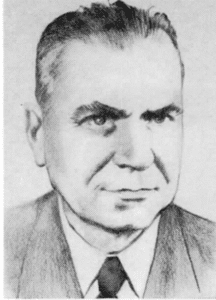
Vaclav Holek.
The Praga factory was the originator of the pistol manufacturing industry in the Czechoslovakian Republic. Production began in the fall of 1918. The gun smith A. Nowotny was the founder of this factory.
The first product of this factory was the blowback, striker-fired VZ.21 pistol in cal .25 Auto VZ. is the abbreviation for Vzor, the Czech word for model.
Vaclav (Wenceslas) Holek, the designer of this pistol, later became famous for his design of the Bren gun.
Unusual Shape
The VZ.21 had a rather unusual shape. The forward part of the slide was cut for the first finger with the idea of permitting one-hand loading. There was no trigger guard. The folding trigger was released during cocking, which was accomplished by moving the slide backward.
There was no manual safety on this pistol, but the design and operation of the folding trigger was considered to be an adequate safety feature. The commercial sales were limited with only a few thousand sold for export.
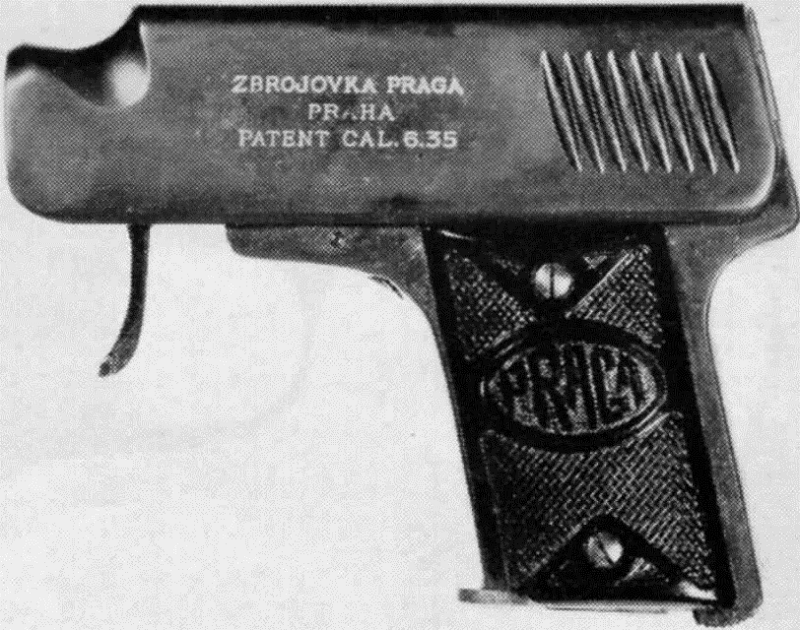

Praga Model 21 cal. .25 pistol.
The second product of the Praga factory was another blow back pistol in cal. .32. There was no model number assigned to this pistol. However, it can be readily identified since it was the only Czechoslovakian pistol made prior to 1938 which had an oval-shaped ejection opening on the top of the slide. The ejection opening resembled that of the old-model Italia n Beretta pistol chambered for the 9 mm. Glisenti cartridge.
The shape of the Praga .32 pistol bears a definite resemblance to the FN Browning Model 1910, though it has no grip safety. The exact number of .32 Praga pistols manufactured is not known, but 4000 were made in the year 1920 alone. Production of this model was discontinued in 1922.
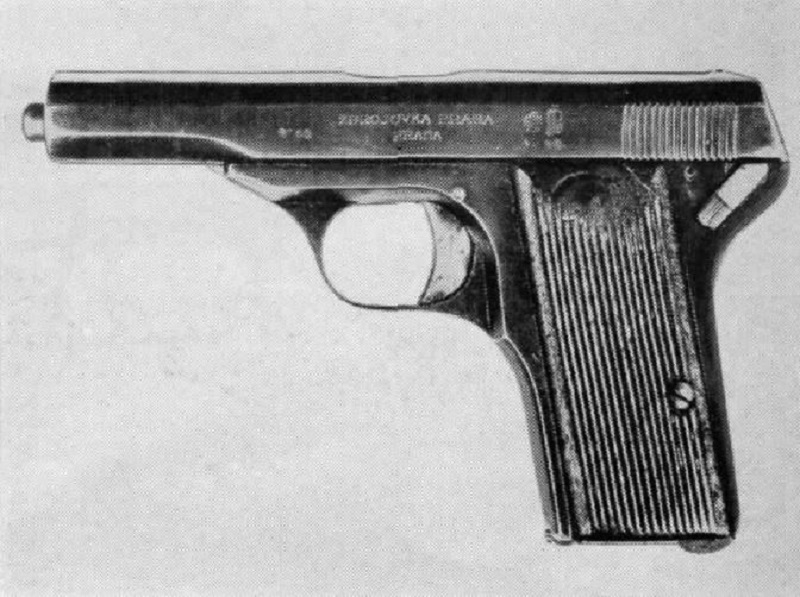

Praga cal. .32 pistol.
The .32 Praga pistol was adopted by the Czechoslovakian Ministry of Internal Affairs as the first official Czechoslovakian police pistol. It was made with 2 different inscriptions appearing on the left of the slide, “ZBROJOVKA PRAGA” or “ZBROJOVKA PRAGA PRAHA”. Pistols produced for the police had serrated wooden grip, while those produced for the commercial market had rubber grips and were marked with the inscription “PRAGA”.
Karel (Charles) Krnka joined this company in 1923. He had formerly been chief arms designer at the G. Roth factory in Austria. During his employment with G. Roth, he designed the Roth Mod. 1907 pistol, chambered for the 8 mm. Roth-Steyr cartridge. This weapon was adopted by the Austro Hungarian Army.
Frantisek Myska
Another designer of the Praga factory was Frantisek (Frank) Myska, who left this factory in 1922 for the Czech Arms Factory, Ltd. He later became prominent because of his excellent pistol designs.
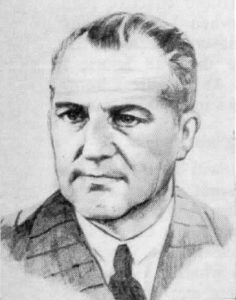

Frantisek Myska.
Due to the steady depletion of capital reserves, the Praga Arms Factory became the property of the Industrial Bank. In 1926 the factory was closed. Most of the members of the Praga design team found new employment in the Czechoslovakian Arms Factory, Ltd., or the Czech Arms Factory, Ltd.
The Czechoslovakian Arms Factory, Ltd. was not only famous for the manufacture of weapons, but also automobiles, sewing machines, refrigerators, and balances. It was established Mar. 1, 1919, in the former Artillery Works under the name “Ceskoslovenke Zavody na Vyrobu Zbrani” (Czechoslovakian Factory for Arms Manufacture ).
Due to the fact that the factory was state-owned, export business was not allowed, and the name was changed to “Ceskoslovenska Zbrojovka Akciova Spolecnost” (Czechoslovakian Arms Factory, Ltd.), thus permitting export of its products. The ownership of the factory was divided as follows: 75 % Government, 20% Skoda Works, and 5% employees . The original factory was located in Brno, Moravia.
The Czechoslovakian Arms Factory, Ltd ., with the valuable assistance of Josef Nickl, a former engineer with the Mauser Work in Germany, originated the prototype of the first Czechoslovakian Army pistol, the VZ.24. The design of this weapon was based on the rotating barrel lock, and it was chambered for the 9 mm. short (.380 Auto) cartridge.
In 1923 the Czechoslovakian Ministry of National Defense decided that the Czechoslovakian Arms Factory, Ltd. would produce only rifles, machine guns, and hunting weapons. Consequently the pistol production was transferred to the Czech Arms Factory, Ltd.
The Czech Arms Factory, Ltd., gained renown through its production of high quality bicycles, motorcycles, machinery, sub-machine guns, and pistols. Karel (Charles) Bubla, an architect, and the directors of the Skoda Works, Hanus, Hasek, and Havranek, were the founders of this company, which was first known under the name “Jihoceska Zbrojovka s.s.r.o.” (South Bohemian Arms Factory, Ltd.).
Production started in the Bohemian city of Pilsen in the Habelmayer Mill in 1919 under the supervision of Alois Tomiska who had learned gunsmithing in Vienna. Tomiska was not by any means new to the production and design of weapons as he had previously designed the pistol, sold under the trade name “Little Tom”, manufactured by Wiener Waffenfabrik in Austria. This pistol was unique because of its trigger design. Pressing the trigger cocked and discharged the hammer as in double-action revolvers. This idea was later used by Walther in an improved form in his PP and PPK Model pistols. In 1921 the factory was moved from Habelmayer Mill to new quarters in the city of Pilsen.
The first product of the South Bohemian Arms Factory, Ltd., was the “Fox” cal. .25 blowback pistol. This pistil had a folding trigger and no trigger guard. It is interesting to note that this pistol had no movable slide; only the breechblock moved during firing. The grips were made of hard rubber and marked with the inscription “Z1”. This pistol was later modified and sold as the CZ VZ. 1922.
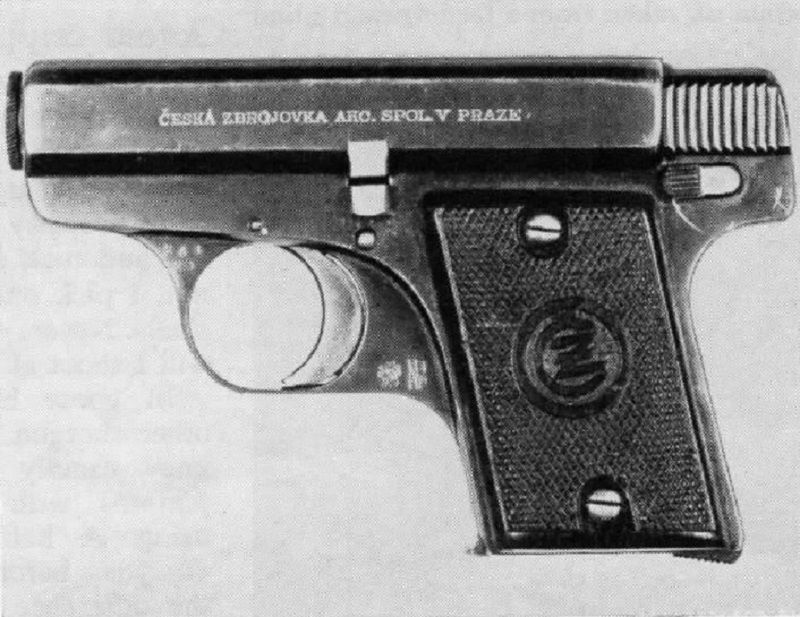

CZ Model 1922 cal. .25 pistol.
In 1922 the South Bohemian Arms Factory , Ltd., absorbed the Hubertus factory and the name was changed to “Ceska Zbrojovka A S.” (Czech Arms Factory, Ltd.). The main factory of this company was located in the Bohemian city of Strakonice.
Other factories were located in Prague and Uhersky Brod, Moravia. When the pistol production was transferred in 1923 from Czechoslovakian Arms Factory, Ltd., to the Czech Arms Factory, Ltd., the latter became the largest pistol manufacturer in Czechoslovakia and produced the majority of all Czechoslovakian civilian, military, and police pistols.
The arms designer Frantisek (Frank) Myska, who had formerly worked with Josef Nickl, the engineer at the Czechoslovakian Arms Factory, Ltd., Brno, on the design of the VZ.24 pistol, was the factory’s most prominent pistol designer. During his career there he designed several excellent pistols. The first problem given to Myska was to redesign and modify the turning-barrel lock VZ.24 .380 pistol to a .32 blowback pistol.
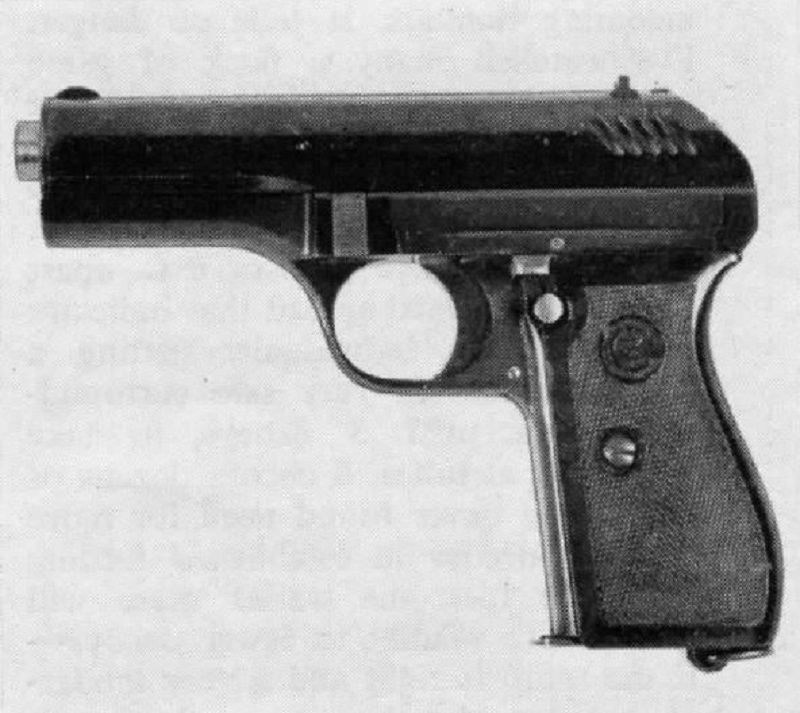

CZ Model 24 cal. .380 pistol.
This was successfully accomplished in 1926, and the new pistol was designated VZ.27.
This pistol saw extensive use as a Czechoslovakian police pistol.
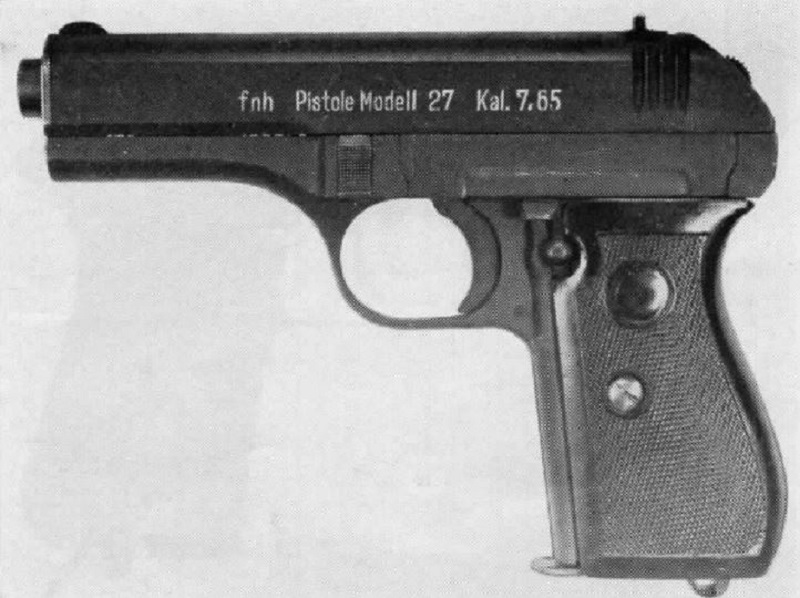

CZ Model 27 cal. .32 pistol.
Myska also designed some pistols for the civilian market.
In 1927 he designed a double-action pistol (Czechoslovakian Patent No. 2814) in which pulling the trigger cocked and released the hammer, and the movement of the slide was used only to eject the spent cartridge and load a new one into the chamber.
In 1934 the VZ.36 pistol was designed on this principle. This weapon in cal. .25 had a thumb safety on the left side of the receiver just over the trigger.
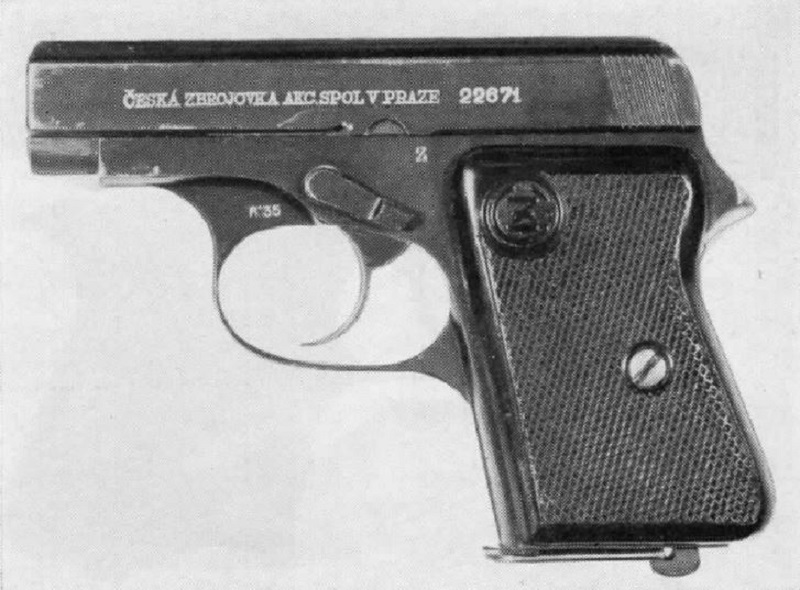

CZ Model 36 cal. .25 pistol.
It was later simplified by Jaroslav Kratochvil and designated VZ. 1945. There was no thumb safety on this pistol, but it had a magazine disconnector. It remained in production until 1951.
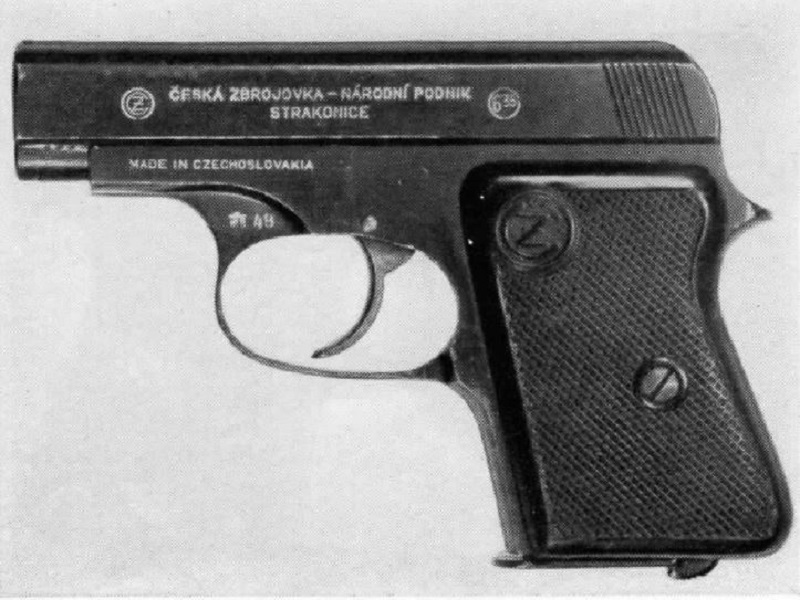

CZ Model 45 cal. .25 pistol.
The last pistol design by Frantisek Myska was in 1937. It was a double-action pistol designated VZ.38 cal. .380 (Czechoslovakian Patent No. 65,558). Production of this pistol started in 1938. The Czechoslovakian Army started equipping itself with this pistol, but this was not completed because of the German occupation on Mar. 15, 1939.
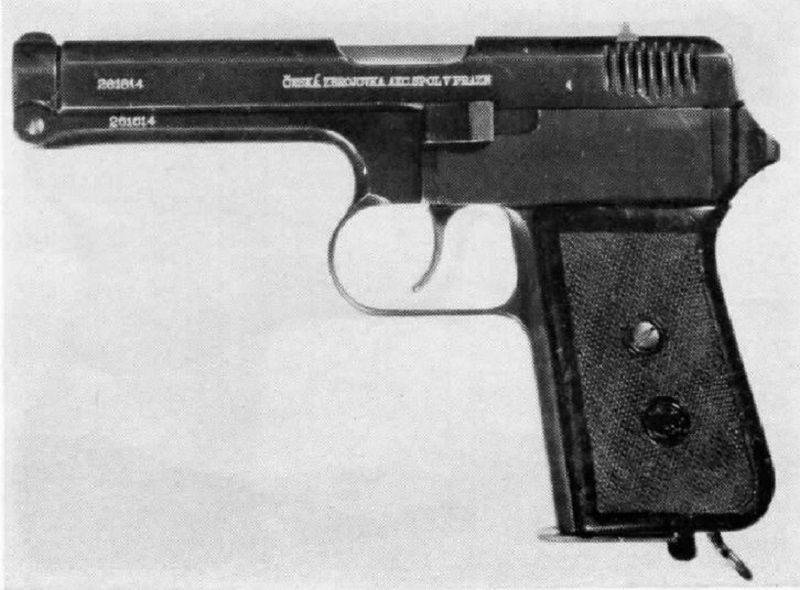

CZ Model 1938 cal. .380 pistol.
German Occupation
During the German occupation this factory was given the code “fnh” under which many VZ.27 pistols were produced. The left side of the slide on this pistol is marked “fnh Pistole Modell 27, Kal. 7.65” and on the top of the slide “Bohmische Waffenfabrik A.G. in Prag”. These pistols have a poor, wartime finish. Sheet metal stampings were used for the firing pin retainer, sideplate, and magazine catch. All have a magazine disconnector, a feature not practical for a military or police weapon.
After the nationalization of arms manufacturers in Czechoslovakia in 1948, this factory changed its name to “Ceska Zbrojovka-Narodni Podnik, Strakonice” (Czech Arms Factory, National Cooperative, Strakonice).
A pistol introduced by the Czech Arms Factory after the nationalization of arms manufacturers was the cal. .32 Model 1950. Of blowback type, this pistol featured a double-action trigger and external hammer, and was similar in appearance to the German Walther PP Model pistol. It was designed in 1947 by Jaroslav and Jan Kratochvil, and was intended for Czech police use. However, it was also produced for the commercial market and for export. Specimens are marked “CESKA ZBROJOVKA NAR. PODNIK STRAKONICE”, or “CESKA ZBROJOYKA PRAHA”.
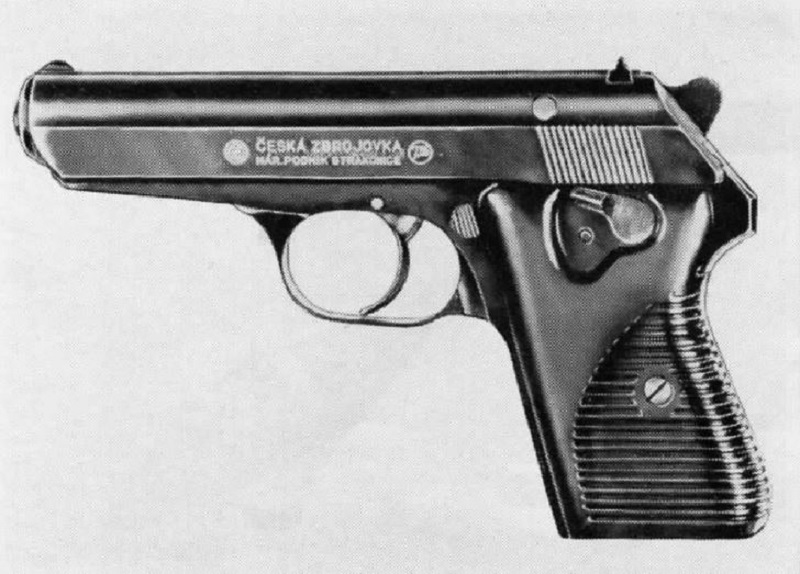

CZ Model 1950 cal. .32 pistol.
Another relatively late pistol is the cal. 7.62 mm. Model 1952, which is currently (as of 1964) the Czech Service pistol. It is adapted to the powerful 7.62 mm. bottle-necked pistol and sub-machine gun cartridge, and has a short-recoil mechanism with dual locking rollers.
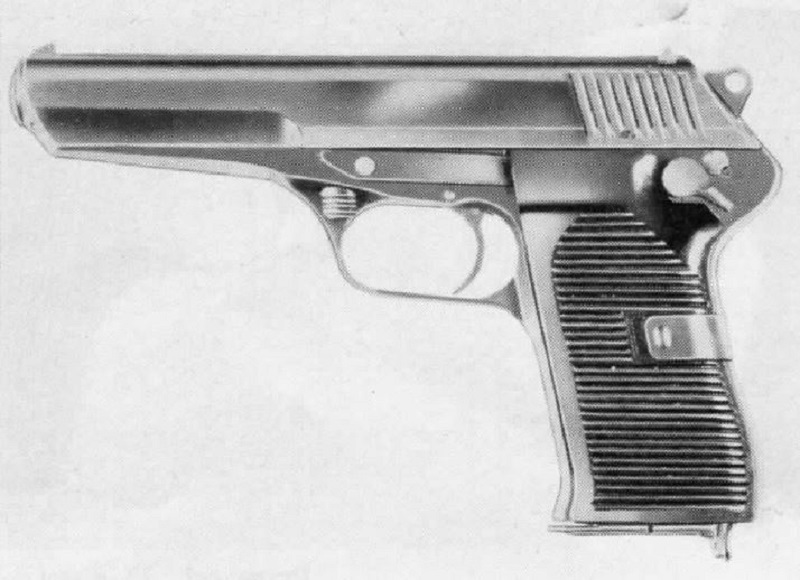

Model 1952 cal. .30 pistol.
Frantisek (Frank) Dusek in Opocno, Bohemia, produced for the home and export markets the blowback, striker fired “Duo” pistol in cal. .25. This pistol was very similar to the FN-made Browning standard-size .25 pistol, but had no grip safety. The magazine was interchangeable with the one from the Browning pistol. Pitol produced by Dusek prior to March 1939 or after May 1945 were marked on the left side “AUT. PISTOLE DUO CAL 6.35 F. DUSEK, OPOCNO.”
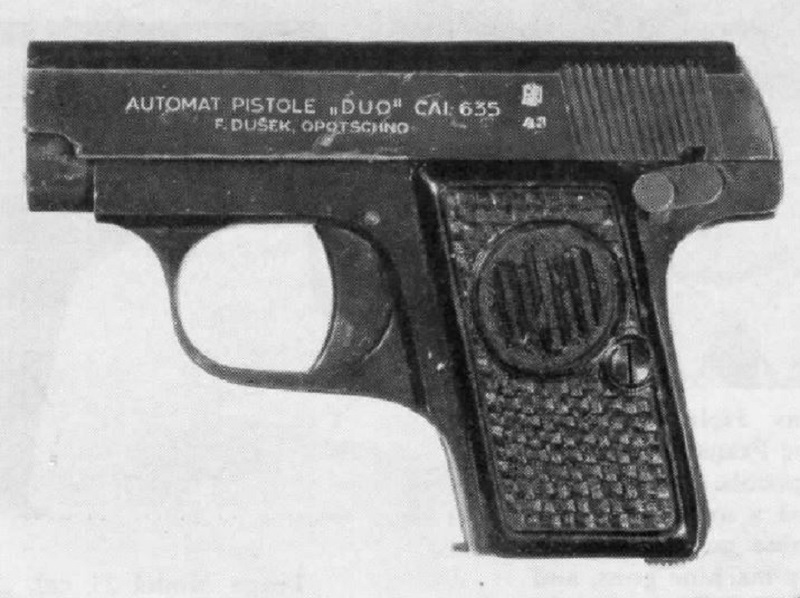

Duo cal. .25 pistol.
During the German occupation of Czechoslovakia from March 1939 until May 1945, the Dusek factory produced parts for small arms used by the German Army, which were coded aek”. Production of Duo pistols continued during the German occupation, and pistols made in this period were mark ed on the left side of the slide ‘AUTOMAT PISTOLE “DUO” CAL 6.35 F. DUSE K, OPOTSCHO’. A limited number of Dusek’s pistols produced during the German occupation were marked on the left side of the slide “AUTOMAT. PISTOLE JAGA 6.35”. The hard rubber grips were also marked with the trade name “JAGA”.
The nationalization of privately owned arms manufacturers in Czechoslovakia in the year 1948-1950 did not interrupt production in Duseks factory. Weapons produced during the nationalization period bore the following marking on the left side of the slide: “AUT. PISTOLE DUO R. 6.35 mm CZ MADE IN CZECHOSLOVAKIA.”
Grips on these pistols were still marked with the trade name “DUO”. Nickel-plated pistols had brown grips. When the nationalization was completed, the inscription on the left side of the slide was changed to “AUT. PISTOLE Z R.6.35 mm. Made in Czechoslovakia. The grips on the e pistols were marked “Z”‘ instead of “DUO”.
According to European arms references, the Dusek factory also produced a very limited number of cal. .25 pistols under the trade names “Ideal” and “Perla”. These were produced prior to 1938. The Ideal was a copy of the cal.
.25 Browning pistol, and the Perla closely resembled the German Menz Lilliput pistol.
Antonin Vilimec in the town of Kdyne, Bohemia, produced a blowback, striker-fired pistol in cal. .25 under the trade name “Slavia”. Two different markings were put on the left side of the slide on these pistols. Some were marked with the trade name “SLAVIA”; others were marked “A. VILIMECNOVA KDYNE SLAVIA”. While there was a slight difference in the shape of the grips on these pistols, both bore the name “SLAVIA”. The peak of production of Slavia pistols was between 1930 and 1933. During the period 1937-1938, production of these pistols was discontinued and the factory was dissolved.
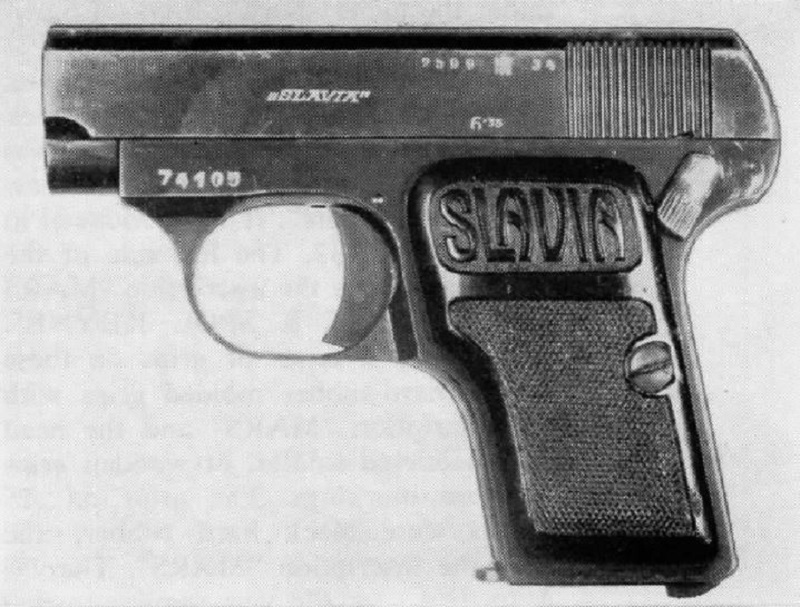

Slavia cal. .25 pistol.
“Posumavska Zbrojovka-Kohout & Spol. Kdyne” (Posumavska Arms Factory, Kohout & Co.) was also located in Kdyne, Bohemia. The first weapon produced by this company was sold under the name “Niva”. It was a blowback , striker-fired pistol in cal. .25.
The second weapon produced was named “PZK”. It was also a blowback striker-fired .25. The PZK pistol was later modified and sold under the new trade name “Mars”. It was produced in cals. .25 and .32. The left side of the Mars pistol bore the inscription “MARS 7.65 KOHOUT & SPOL KDYNE”.
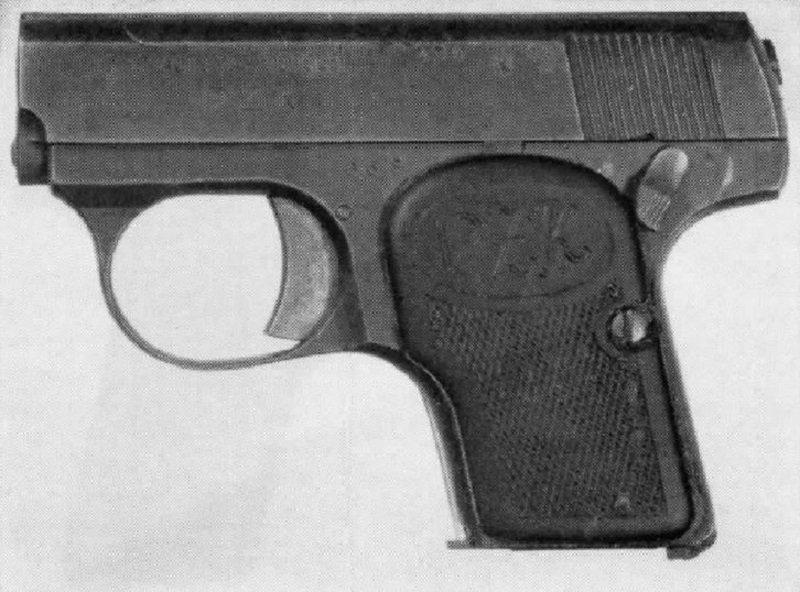

PZK cal. .25 pistol.
There were 2 types of grips on these pistols, hard-rubber molded grip with the inscription “MARS” and the head of a helmeted soldier, or wooden grips with no marking. The grips on .25 pistols were black hard rubber, and bore the inscription “MARS “.
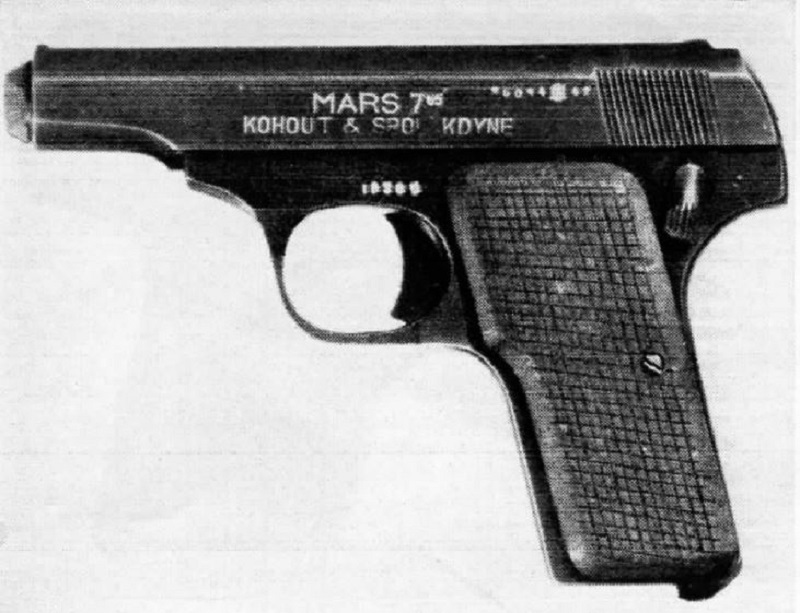

Mars cal. .32 pistol.
The .32 Mars had a profile very similar to that of the FN-Browning Model 1910. The Mars pistol was the lowest-priced pistol in its class produced in Czechoslovakia before 1938. Kohout & Co. continued production of Mars pistols during the German occupation. In 1945 production stopped and has never been resumed.
Simple Target Pistol
A very simple pistol was produced by Frank Pavlicek in the Bohemian city of Litomyl. Until 1951 it was the only Czechoslovakian-made single-shot target pistol in cal. .22. This weapon was of top-break type. Locking was accomplished by pressing a button on the left side of the action. It was necessary to cock the hammer manually for each shot. The operation of the hammer was similar to that of the U.S.-made Smith & Wesson Straight-Line pistol.
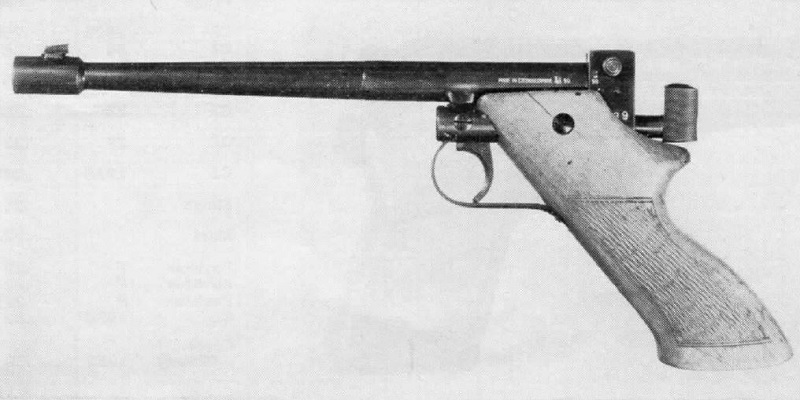

Pavlicek Model P pistol.
These pistols were made with 3 different barrel lengths and 2 different shapes of grips. There was no manufacturer’s name and no markings as to the model on Pavlicek’s pistols. After the nationalization of the Czechoslovakian arms industry in 1958, these pistols were called “P” series pistols.
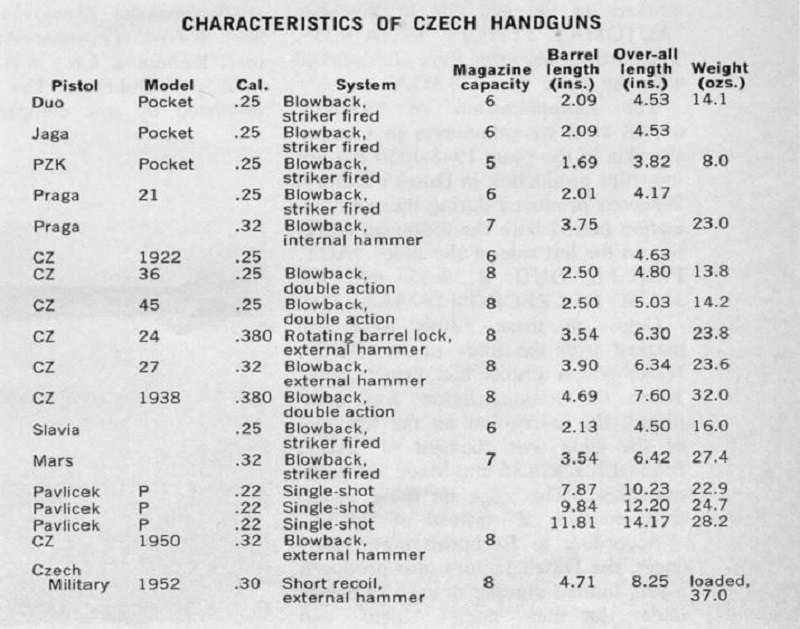

This article originally appeared in the January 1964 issue of The American Rifleman. It was written by V. J. Krcma, Firearms Examiner, Attorney General’s Crime Laboratory, Toronto, Canada.
Mr. Vaclav Krcma also wrote a book entitled The Identification and Registration of Firearms in 1971.
While out of print, you can still find a copy occasionally on Amazon; here, here or here.
Vaclav ‘Jack’ Wenzel Krcma passed away on May 17, 2009 at the age of 87.
If you have not already subscribed to get TresBohemes.com delivered to your inbox, please use the form below now so you never miss another post.
Remember, we rely solely on your donations to keep the project going.
Become a friend and get our lovely Czech postcard pack.


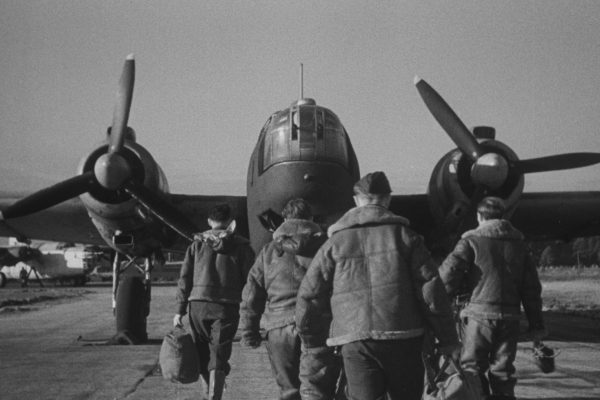

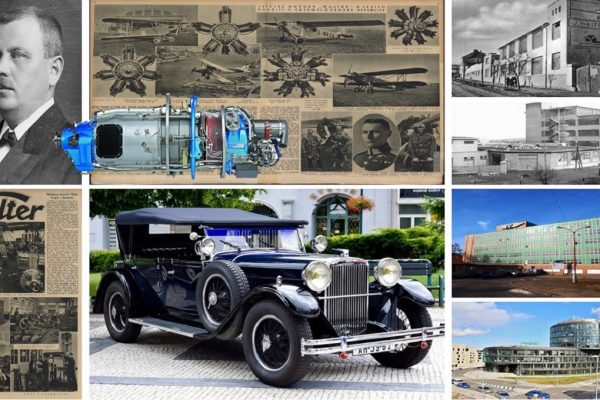















I have a little Havia gun, It appears it might be a cap gun. I would like to know more about it. Can you give me a place I can send a picture and get some info?